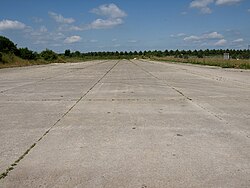Augsburg-Haunstetten airfield
| Augsburg Airfield (-Haunstetten) Augsburg Army Airfield |
|
|---|---|

|
|
| Characteristics | |
| ICAO code | EDMA |
| Coordinates | |
| Height above MSL | 497 m (1631 ft ) |
| Transport links | |
| Distance from the city center | 3 km southeast of Augsburg |
| Street |
|
| Basic data | |
| opening | November 1916 |
| closure | July 21, 1968 |
| Start-and runway | |
| 03/21 | 1000 m × 50 m grass |
The first Augsburg airport was built south of the city center during the First World War, initially as a works airport for the aviation industry. In the interwar period, it later served as Augsburg's commercial airport and after the Second World War it was operated by the United States Army for almost two decades . After the military withdrew in the early 1960s, it was used civilly for a few years. In 1968 it was replaced by today's Augsburg airfield and most of the airfield was built over.
history
The first airfield in Augsburg was built on November 25, 1916 with the construction of three production halls by "Bayerische Rumpler-Werke AG", a subsidiary of the Berlin Rumpler Flugzeugwerke GmbH . For the settlement of this company, the city acquired an area on Haunstetter Strasse south of the city center, which was left to Rumpler. On July 1, 1917, the first Rumpler C1 took off from the airfield. After the First World War, civil air traffic was handled on the site. The company Rumpler aviation transported passengers and mail bags on the domestic German route Augsburg-Munich-Fürth / Nuremberg-Leipzig-Berlin and back. The first machine arrived in Augsburg on March 13, 1919. The day marks the beginning of civil aviation in Bavaria. From 1922 the company came under competitive pressure and had to merge in 1923.
The new company Bayerische Flugzeugwerke AG (BFW), which has now been created , acquired the halls of the former Rumpler works on July 30, 1926. The Udet U 12 aircraft that had been produced took off from the works airfield . Civil aircraft were manufactured under Willy Messerschmitt , who came to Augsburg , until 1934. In the period after that, the BFW built more and more military aircraft. Messerschmitt AG , which emerged from the BFW in 1938 , received its orders from armaments production. First flights for newly developed types were carried out from the works airfield , including by test pilot Fritz Wendel .
The Augsburg airfield at that time was not very well developed as a commercial airport and had no taxiways , it was a pure meadow airfield . It became a preferred target for Allied bombers during World War II because of the Messerschmitt works . In the spring of 1945, after the invasion of the Americans, the Haunstetten Airfield or Airfield R.84 , the allied code designation, was confiscated and used by the military until 1963. However, from 1952 the Americans allowed Germans to glide in the southern part and in 1955 they also allowed them to be used by powered aircraft .
At the end of the 1950s, considerations arose to include the area in future urban development. In the fall of 1963, the Americans relocated their approximately 25 aircraft stationed at the airfield to the Gersthofen-Gablingen airfield . The state lease expired on April 30, 1964 and Augsburg was able to dispose of the land again.
On July 21, 1968, when the last aircraft took off, flight operations at what was now the "old airfield" ended.
Todays use
Messerschmitt remained at this location and operates today as Premium Aerotec GmbH.
From 1972, wings for the University of Augsburg were built on another part of the large site . A residential and commercial area was also created. The newly created district has been known as the university district since 1979 .
Web links
- History trail page about the airfield
- Information on forgotten airfields
- Information on Military Aircraft Directory
Individual evidence
- ^ " Augsburger Allgemeine " from October 15, 2009: Rumpler double-decker from Augsburg
- ↑ "Augsburger Allgemeine" from October 22, 2009: Messerschmitt shaped an era
- ^ "Augsburger Allgemeine" of November 12, 2009: The university district is on the airfield